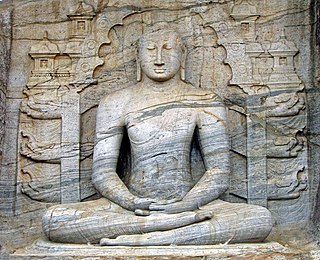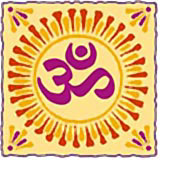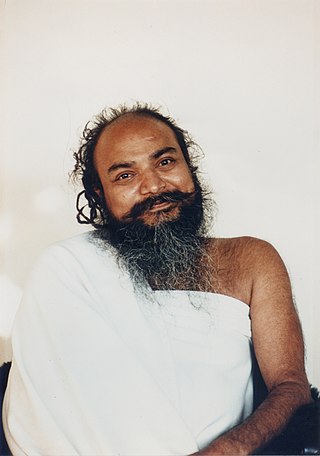
Samādhi, in Hinduism, Buddhism, Jainism, Sikhism and yogic schools, is a state of meditative consciousness. In many Indian religious traditions, the cultivation of Samādhi through various meditation methods is essential for the attainment of spiritual liberation.

Ramakrishna, also called Ramakrishna Paramahansa, born GadadharChattopadhay, was an Indian Hindu mystic. A devotee of the goddess Kali, Ramakrishna after adhering to various religious practices from the Hindu traditions of Vaishnavism, Tantric Shaktism, and Advaita Vedanta, as well as from Islam and Christianity, proclaimed that various world religions are "so many paths to reach one and the same goal", thus validating the essential unity of religions. His parable-based teachings espoused the ultimate unity of diverse religions as being means to enable the realization of the same God. He is regarded by his followers as an avatar or divine incarnation of God.

Nisargadatta Maharaj was an Indian guru of nondualism, belonging to the Inchagiri Sampradaya, a lineage of teachers from the Navnath Sampradaya.
Pratyahara or the 'gathering towards' is the fifth element among the Eight stages of Patanjali's Ashtanga Yoga, as mentioned in his classical work, Yoga Sutras of Patanjali composed in the 2nd century BCE. It is also the first stage of the six-branch yoga (ṣaḍaṅgayoga) of the Buddhist Kālacakra tantra, where it refers to the withdrawal of the five senses from external objects to be replaced by the mentally created senses of an enlightened deity. This phase is roughly analogous to the physical isolation phase of Guhyasamāja tantra.

Swami Shivananda (1854–1934), born Tarak Nath Ghosal, was a Hindu spiritual leader and a direct disciple of Ramakrishna, who became the second president of the Ramakrishna Mission. His devotees refer to him as Mahapurush Maharaj. Shivananda and Subodhananda were the only direct disciples of Ramakrishna to be filmed. He was a Brahmajnani. Shivananda introduced the celebration of the birthdays of his brother-monks. He was known to have laid the foundation stone of Shri Ramakrishna Temple at Belur Math, which was designed by Vijnanananda.

Dhyāna in Hinduism means contemplation and meditation. Dhyana is taken up in Yoga practices, and is a means to samadhi and self-knowledge.

Ramakrishna Paramhansa Deva had sixteen direct disciples who became monks of the Ramakrishna Order; they are often considered his apostles. In the Ramakrishna-Vivekananda movement, the apostles have played an important role. Apart from Swami Vivekananda, the direct disciples or apostles of Ramakrishna were as follows.

Pranava yoga is meditation on the sacred mantra Om, as outlined in the Upanishads, the Bhagavad Gita, and the Yoga Sutras of Patanjali. It is also called Aum yoga and Aum yoga meditation. It is, simply put, fixing the mind on the sound of the mantra "Aum" – the sacred syllable that both symbolizes and embodies Brahman, the Absolute Reality – as the mantra is constantly repeated in unison with the breath. The purpose of pranava yoga is to become free from suffering and limitation.
Samyama is the combined simultaneous practice of Dhāraṇā (concentration), Dhyāna (meditation) and Samādhi (union).

Sri Siddharameshwar Maharaj (1888–1936) was a guru in the Inchagiri Sampradaya founded by his guru Bhausaheb Maharaj, a branch of the Navnath Sampradaya, the 'Nine Masters' tradition in India. His disciples included Nath teachers Nisargadatta Maharaj, Ranjit Maharaj, Kaadsiddheshwar, and Ganapatrao Maharaj Kannur.

Shri Shivabalayogi Maharaj was a yogi who claimed to have attained self-realization through twelve years of arduous tapas, meditating in samādhi for an average of twenty hours a day.

Shivarudra Balayogi Maharaj, born Srinivas (Seenu) Dikshitar in Kolar in the South Indian state of Karnataka, is a self realised Yogi and a direct disciple of Shivabalayogi.
Bhava Samadhi is a state of ecstatic consciousness that can sometimes be a seemingly spontaneous experience, but is recognized generally to be the culmination of long periods of devotional practices. It is believed by some groups to be evoked through the presence of "higher beings." "Bhava" means "feeling", "emotion", "mood", "mental attitude" or "devotional state of mind." "Samadhi" is a state of consciousness in which the mind becomes completely still and the consciousness of the experiencing subject becomes one with the experienced object. Thus, "bhava samadhi" denotes an advanced spiritual state in which the emotions of the mind are channelled into one-pointed concentration and the practitioner experiences devotional ecstasy. Bhava samadhi has been experienced by notable figures in Indian spiritual history, including Sri Ramakrishna Paramahamsa and some of his disciples, Chaitanya Mahaprabhu and his chief disciple Nityananda, Mirabai, Kundalini Guru Shri Anandi Ma, and numerous saints in the bhakti tradition.
Pavhari Baba (1798–1898) was a Hindu ascetic and saint. He was born in Premapur, Jaunpur in a Brahmin family. In his childhood he went to Ghazipur to study under the tutelage of his uncle who was a follower of Ramanuja or Shri sect. After finishing his studies he travelled to many places. At Girnar in Kathiawar he was initiated into Yoga.

Swami Turiyananda or "Hari Maharaj" as he was popularly known as, was a direct monastic disciple of Ramakrishna, the 19th-century Hindu mystic from Bengal. He was one of the earliest missionary to be sent by his leader and brother disciple Swami Vivekananda to the United States of America to preach the message of Vedanta to the western audience from 1899 to 1902. He established the Shanti Ashrama in California, United States. He was a monk of the Ramakrishna Mission. He left his mortal body in Varanasi, India.
Meditation played a very important role in the life and teachings of Swami Vivekananda. He was interested in meditation from his childhood. His master Ramakrishna found him a dhyana - siddha . On 24 December 1892, Vivekananda reached Kanyakumari and meditated for three days on a large rock and took the resolution to dedicate his life to serve humanity. The event is known as the Kanyakumari resolve of 1892. He reportedly also meditated for a long time on the day of his death.

The relationship between Ramakrishna and Vivekananda began in November 1881, when they met at the house of Surendra Nath Mitra. Ramakrishna asked Narendranath to sing. Impressed by his singing talent, he invited him to Dakshineswar. Narendra accepted the invitation, and the meeting proved to be a turning point in the life of Narendranath. Initially Narendra did not accept Ramakrishna as his master and found him to be a "mono maniac", but eventually he became one of the closest people in his life. Ramakrishna reportedly shaped the personality of Narendranath and prepared him to dedicate his life to serve humanity. After the death of Ramakrishna, Narendra and his other monastic disciples established their first monastery at Baranagar.
In Advaita Vedanta and Jnana Yoga Nididhyasana is profound and repeated meditation on the mahavakyas, great Upanishadic statements such as "That art Thou", to realize the identity of Atman and Brahman. It is the fourth step in the training of a sisya (disciple), consisting of preparatory practices, listening to the teachings as contained in the sruti, reflection on the teachings, and nididhyasana.

Shri Swami Keshwanand Satyarthi Ji Maharaj was an Indian guru of Shri Nangli Sahib lineage. The spiritual institution Paramhans Satyarthi Mission was led and governed by him. In 1985, Shri Paramhans Swami Ramanand Satyarthi Ji Maharaj anointed him as his spiritual successor and the patron saint of the Paramhans Satyarthi Mission. Swami Keshwanand Satyarthi Ji Maharaj travelled around the world and preached about spirituality and enlightenment. Swami Ramanand Satyarthi Trust, Shri Satyarthi High School, Shri Satyarthi Sevadal and Shri Satyarthi Sandesh Magazine were also administered under his guidance.

Ashtanga yoga is Patanjali's classification of classical yoga, as set out in his Yoga Sutras. He defined the eight limbs as yamas (abstinences), niyama (observances), asana (posture), pranayama (breathing), pratyahara (withdrawal), dharana (concentration), dhyana (meditation) and samadhi (absorption).















